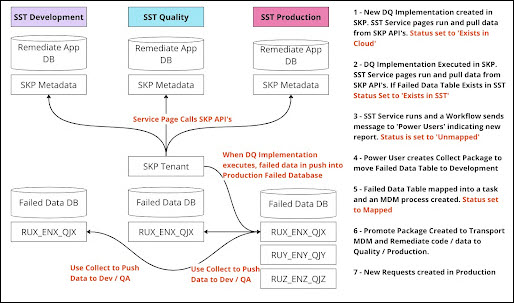Remediate
Remediate is a component of Syniti Master Data Management that allows data that does not conform to data quality rules enforced by the Syniti Knowledge Platform Data Quality solution to be routed to business users for resolution.
Before Getting Started
Request Remediate License
Before Remediate is available, request a new license by submitting a Software License Request.
Update MDM Toolbar (if necessary)
Remediate is a new WebApp within Master Data Management; it is listed on the WebApp toolbar along with Content Configuration.
If the webContentConfiguration_ContextBarTbv view in the DGE_Data database has been modified, upgrading to SST 8.0.5 will overwrite the view’s definition and add a link to the new Remediate WebApp. After the upgrade, simply re-apply your changes to the view.
Set Up
Before getting started with Remediate, ensure the steps in the following sections have been fulfilled. There are setup steps for both the Syniti Knowledge Platform and the Syniti Stewardship Tier:
Data Quality Report Development Lifecycle
The Synti Knowledge Platform does not currently have the concept of multiple tiers. The way to handle the development of data quality rules against a development environment and then execute them against a production environment is to create an implementation that uses a development system/connection and then switch this to a production system/connection once the implementation has been tested.
Regardless of whether an implementation is using a development or a production system/connection, the failed data is always written to the same data store.
The following diagram illustrates the data quality report development lifecycle:

Create Remediation Processes (Production)
This task is performed by MDM developers in the Production environment of MDM.
To create a remediation process in production:
-
Extract data quality jobs from the Syniti Knowledge Platform. This process is run by a service page.
-
Users assigned to the Remediate Power User WebApp group receive a notification that a new data quality report is available for remediation.
-
Decide if data remediation with SST MDM is needed.
-
Create a Collect package to move the failed data table to the SST Development instance. Refer to Collect Build Process for more information.
Create Remediation Processes (Development)
MDM developers create remediation processes in the Development environment of MDM and then move the code to Production.
To create a remediation process in development:
-
Create an MDM task and assign it to a business process / scenario. This step is only needed if there isn’t an MDM scenario for mass updating this type of record. An example of when this task would be needed is if a mass update customer needs to be created, a new report for bad customer records may be able to use the same scenario and task. Refer to Add a Task for more information.
-
Map the data quality report to an MDM category, task and table.
-
Map the failed data table columns to the MDM task table columns.
-
Test the remediation process to ensure the process and postings work as intended.
-
Lock the data quality report mapping, which sets the status to Mapped.
-
Use Promote to transport the remediation process to Quality/Production SST instances.
